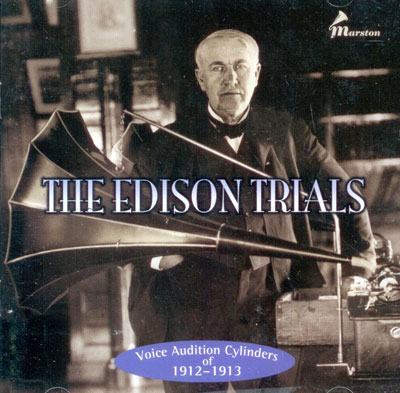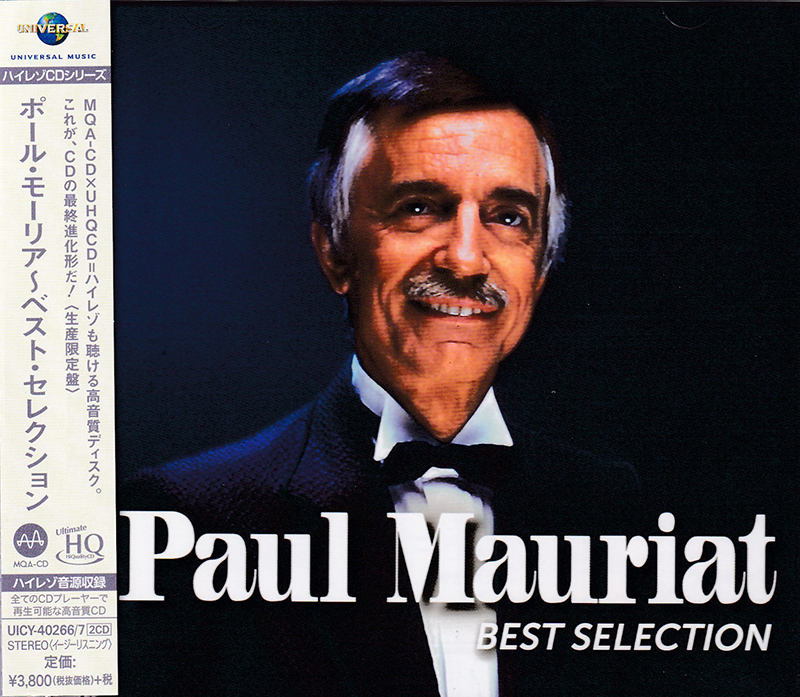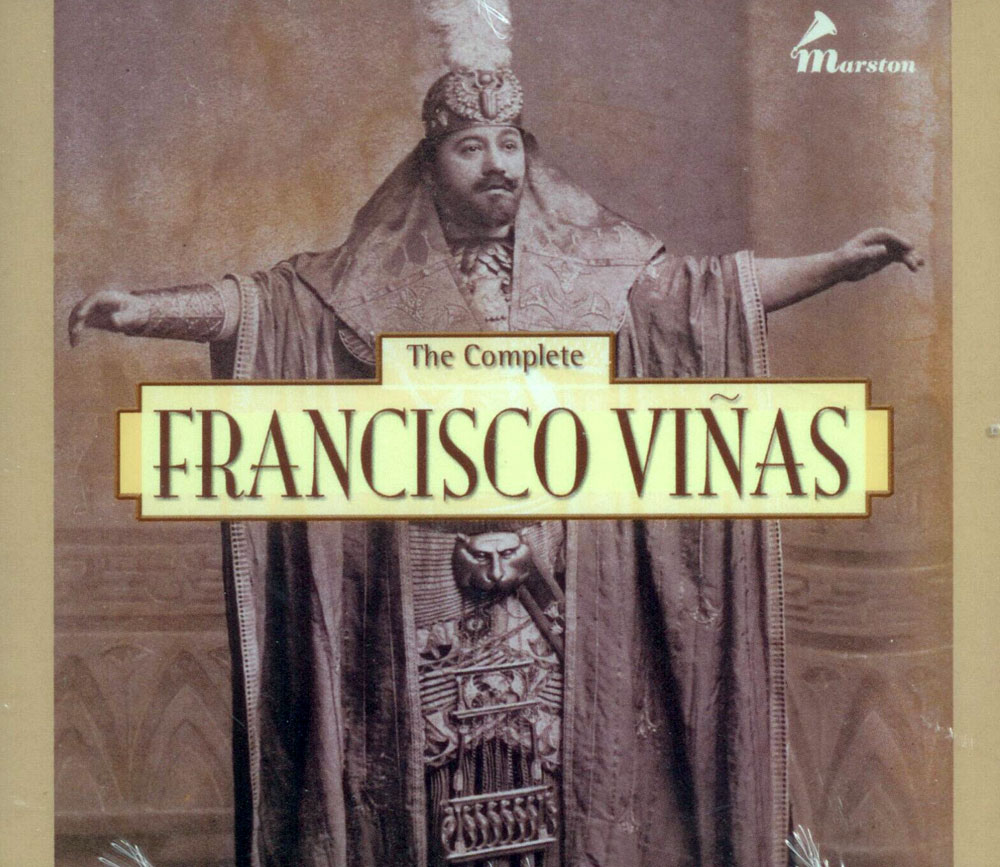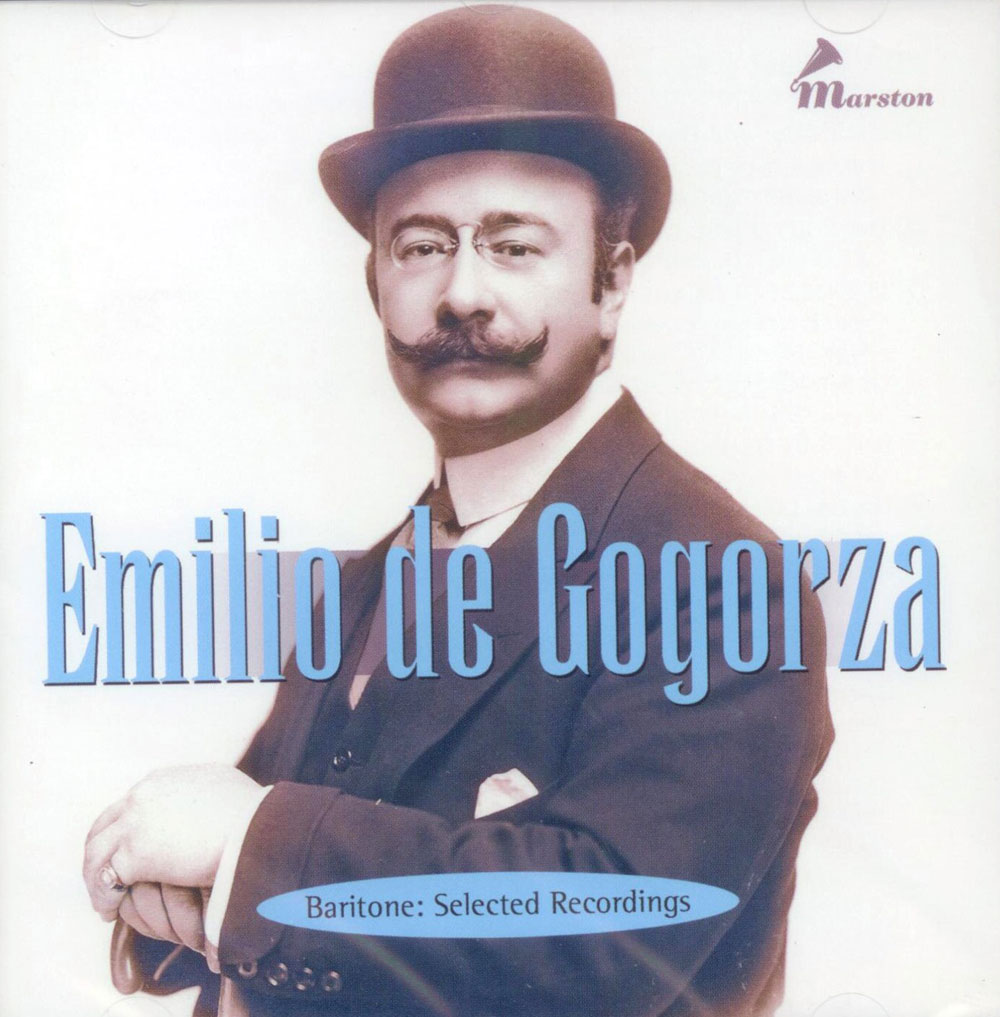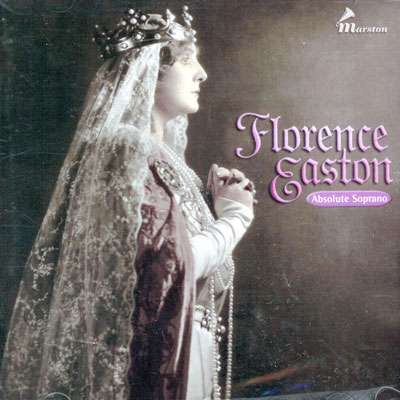Logowanie
Mikołaj - ten to ma gest!
Miles Davis, Horace Silver, Jay Jay Johnson, Percy Heath, Kenny Clarke, Lucky Thompson
Walkin'
20bit K2Super Coding - ale jak to brzmi!
Kasety magnetofonowe
Winylowy niezbędnik
ClearAudio
Double Matrix Professional - Sonic
najbardziej inteligentna i skuteczna pralka do płyt winylowych wszelkiego typu - całkowicie automatyczna
Edison Voice Trials
Voice Audition Cylinders of 1912-1913
- FULGENZIO ABELA [te] (Barcelona, 1880- ? )
- 1. MANON: Ah! fuyez, douce image (Massenet) [It.] 2:12
- Abelas family moved to Buenos Aires during the tenors formative years. He studied there with the Spanish conductor Ivan Goula (who also taught, among others, Blanchart, Vi?as, and Palet). Abelas first performances seem to have been in Buenos Aires in Lucrezia Borgia and Dolores (Bretón). The same year he appeared at the Liceo, Barcelona, in La Favorita and Mefistofele. During the following two decades he sang with considerable success in Italy (Torino, Trevisio, the Dal Verme in Milano, Genova, the Costanzi in Roma and so on) as well as at the Colón in Buenos Aires (1910), Chile, Spain, and Greece. Abelas repertoire included the principal tenor roles in La Traviata, Adriana Lecouvreur, Rigoletto, Tosca, Faust, Boris Godounov, Amico Fritz, and a number of other operas and zarzuelas. His last years were spent in Buenos Aires. No other recordings of Abelas voice have been traced, although the Edison files, which give his age as 34 at the time of the recording (2 July 1912), mention that he made a few records for a German company.
- MARISKA ALDRICH [so] (Boston, 1881-California, 1965)
- 2. Arpeggios 1:01
- MARISKA ALDRICH [so] (Boston, 1881-California, 1965)
- 3. Magasan Repül a Daru, Szépen Szál ((Hungarian Folk Song)) 1:36
- Aldrich studied in Paris with Giraudet and London with Henschel, as well as with several other teachers, making her debut at Covent Garden, 1901, as the Witch in Hansel und Gretel. She was then traced to the Manhattan Opera, first heard there as Urbain in Les Huguenots (with Agostinelli, Zenatello, Sammarco, and Arimondi). She was with the Met, 1909-11, in mezzo roles such as Azucena, Lola, Fricka, and Naoia (in Converses The Pipe of Desire). In 1910 Aldrich sang in a concert performance of Les Troyens (Berlioz) in Cincinnati with Louise Homer, Corinne Rider-Kelsey, Evan Williams, Dan Beddoe, and Herbert Witherspoon. Later she was heard in Wagnerian dramatic roles such as Brünnhilde (which she had been booked to sing at Bayreuth, 1914, the festival however having been suspended because of the First World War). She and her husband, Congressman J. Frank Aldrich, had several children, and possibly her attention to familial duties prevented her career from developing to the fullest. A few years before her death she was a guest on the television show, This Is Your Life in tribute to her colleague, Marguerita Sylva. Aldrich appears not to have recorded other than these two Edison trials. Before the final arpeggio she asks, in German, Genung? (Enough?).
- ALICE ALLIX [so]
- 4. LE CID: Pleurez mes yeux (Massenet) 1:30
- A pupil at the Paris Conservatoire of M. Guillamat, Allix was awarded 1er accessit de Chant upon her graduation in 1913. Five years later she made her debut at the Paris Opéra in Mademoiselle de Nantes. She also sang Aida, Marguerite in Faust, and participated in several premieres, including the role of Alice Ford in the Paris Opéras first Falstaff (1922). At the Trocadéro she sang Tosca in 1922, as well as Françoise in Bruneaus LAttaque du Moulin. She seems to have made no commercial recordings. As in the case with several other Edison French trial artists, the recording of Allix was made shortly after she was graduated from the Paris Conservatoire.
- ADELAIDE ANDREYEVA VON SKILONDZ [so] (St. Petersburg, 1882-Stockholm, 1969)
- 5. LA TRAVIATA: Ah, fors ? lui; Sempre libera (Verdi) 2:17
- Having studied at the St. Petersburg Conservatory, Skilondz made her debut at the Mariinsky Theater in 1904. Among her great successes in Russia was the creation of the role of the Queen of Shemakha (who sings the memorable Hymn to the Sun) in Rimsky-Korsakovs Le coq dor at the Zimin Opera, 1909. Appearing at the Berlin Hofoper until the beginning of World War I in a variety of principal coloratura roles, she subsequently became established in Sweden, first as a leading soprano at the Stockholm Opera and then as a concert singer and voice teacher. Her pupils included Elisabeth Söderström, Kerstin Meyer and Kim Borg. Skilondz made recordings for the German Gramophone Company, Pathé, Parlophon, Ariel and one electrical disc for the Swedish branch of HMV. The Edison trial may be her only recording in Italian.
- FANNY ANITUA [ms] (Mexico, 1887-Mexico City, 1968)
- 6. LA FAVORITA: O mio Fernando (Donizetti) 1:48
- Trained in Italy, Anitua made her debut as Glucks Orfeo. For over two decades she was heard in the principal Italian houses as well as in Spain and North and Central America. Her repertoire included such roles as Cenerentola and Carmen, and at La Scala, 1916, she took part in the world premiere of Pizzettis Fedra. This important artist recorded for Italian Columbia in the 1913-15 period.
- GASTONE BARACCHINI [te]
- 7. LELISIR DAMORE: Una furtiva lagrima (Donizetti) 2:08
- GASTONE BARACCHINI [te]
- 8. Tristezza ((Tosti)) 2:04
- Not much has been discovered on Baracchini other than that he sang at the San Carlo in Naples, substituting for tenor Aristodemo Giorgini in La Sonnambula. No recordings of his voice are known other than these trials.
- AMLETO BARBIERI [ba] (Pisa, 1883-New York, 1957)
- 9. TANNHÄUSER: O du mein holder Abendstern (Wagner) [It.] 2:13
- A pupil of Lelio Casini, Barbieri made his debut at the Politeama in Pisa as Renato in Un Ballo in Maschera. His career encompassed many Italian houses, including La Scala, where in 1914 he sang the role of Rinuccio in the world premiere of Alfanos LOmbra di Don Giovanni. He also made guest appearances in Spain and Austria. After World War I, Barbieri emigrated to the United States and appeared in opera with smaller companies in the New York area, the more important performances having been Iago to Paolis Otello and Amonasro with Iva Pacetti as Aida at the Brooklyn Academy of Music in 1922. His repertoire ran from Alberich (Götterdämmerung) through Jack Rance (La Fanciulla del West). A few Pathé records listed in Girard & Barnes as by Emilio Barbieri are probably by this artist. Hearing this cylinder, Edison made the sort of comment observed throughout his notebooks: An agravating [sic] tremolo kills his voice. No.
- GIULIA BATTAGLIOLI-LEOTTI [so] (c.1880- ? )
- 10. AIDA: O patria mia (Verdi) 2:02
- Battagliolis earliest traced performance was at the Teatro Nuovo, Spoleto, 1905, as Micaela in Carmen. Subsequent performances included seasons in Novara (where she sang Santuzza) and in Barcelona at the Bosque Theater. In 1910 she wed tenor Vincenzo Leotti (another Edison trial artist for whom only arpeggios exist). In 1912 she sang at the Mercadante in Cerignola as Fedora, in company with her husband. Recordings were made by Battaglioli for the Italian Gramophone Company, Favorite, and Phonodisc Mondial. She is also quoted in Edisons notes as having recorded for Fonotipia. These recordings, all pre-dating her Edison trial, were under her maiden name, Battaglioli, and as she does not appear in a 1915 Italian artists directory, she may have retired to raise a family. Edison gave her trial a more positive review than most: Very little tremolo Even and fairly pure scale ... Could only use her in emergency she is best so far but not very promising.
- ANGELO BENDINELLI [te] (Pisa, 1876-Livorno, 1942)
- 11. Mattinata (Leoncavallo) 2:05
- Bendinelli, a student of Cortesi in Pisa and Giacchetti in Firenze, made his debut at the Teatro San Marco in Rossinis Stabat Mater. Subsequent operatic appearances took place thoughout Italy, including Bologna, Mantova, Venezia, and included principal parts in operas such as Rigoletto, Sonnambula, Amico Fritz, Pacchierottis Eidelberga Mia!, Iris, and Manon. Success was also attained in Cairo, Montevideo, and Buenos Aires. Recordings of Bendinelli were made for the Italian Columbia Company and the Italian Gramophone Company in the 1912-13 period.
- MARGHERITA BEVIGNANI [so] (1887-Milano, 1921)
- 12. LA SONNAMBULA: Come per me sereno (Bellini) 2:17
- Bevignanis debut took place in 1909 at the Politeama Garibaldi in Treviso as Micaela, following a period of study with Mo. Perilli. She was subsequently heard in Brescia and Bari, and later toured South America, having particularly great success, in Argentina and Chile. In 1918 she was diagnosed with tuberculosis, and this leading to her early death. The operas in which she was noted include Rigoletto, La Sonnambula, Il Barbiere di Siviglia, Lucia, and La Traviata. Recordings of Bevignani were made for Favorite and the Italian Gramophone Company (including Violetta in a complete La Traviata, 1915).
- LÉON BEYLE [te] (Lyon, 1875-1922)
- 13. WERTHER: Pourquoi me réveiller (Massenet) 2:13
- A student of the conservatories at Lyon and Paris, Beyle made his Paris Opéra debut in 1897 as Don Ottavio in Don Giovanni. His career there comprised more than forty roles including Florestan, Tamino, Turiddu, and Pinkerton, but it was as Werther that he was particularly identified. He also appeared throughout the French provinces. Beyle made a number of records for the French Gramophone Company and Pathé. His Edison trial has the unfortunate distinction of singer and accompanist parting company during the second strophe.
- PAUL BLANCARD [bs] (Toulon, 1869- ? )
- 14. Unidentified French Aria/Song 2:13
- Blancard was originally a medical student, but in working with a teacher at the Paris Conservatoire he decided to prepare for an operatic career. Beginning 1894 as a performer in a number of French theaters and salons, he made his debut at la Monnaie, Brussels, in 1896 as Nilakanta to Landouzys Lakmé, and sang several other roles there with considerable success, returning for the 1906-08 seasons. 1897-98 he appeared at the Théâtre Français in the Hague, 1899-1900 at Marseille, and then with the opera at Lyon. His Opéra-Comique debut was as Don Basilio in Il Barbiere di Siviglia, 1908, with Korsoff, Francell, Vigneau, and Allard. Blancards repertoire was large, including a number of contemporary works, several premieres, and the principal bass roles in such operas as Mignon, Aida, Roméo et Juliette, Faust, and Manon. No other recordings of his voice have thus far been traced, nor has the music he selected for his Edison trial as yet been identified.
- EBE BOCCOLINI-ZACCONI [so] (Ancona, 1889- ? )
- 15. MEFISTOFELE: Laltra notte (Bo?to) 1:57
- Studying in Bologna with Giordano Russo, Boccolini first came to attention as Nedda (Pagliacci) at the Politeama in Pisa, 1906. Despite her youth, she was soon heard in a number of Italian houses in roles such as Charlotte in Werther, Wally, Manon, Madama Butterfly, Conchita (Zandonai), Desdemona, and Tosca. Her career encompassed most of the Italian theaters, and she also sang in Holland, Spain and Chile. Her husband was Ermete Zacconi, a noted Italian actor. Boccolini recorded for the Italian Gramophone Company, several of the discs having also been issued by Victor.
- GIUSEPPINA BONETTI [ms] (Venice, 1883-Venice, 1963)
- 16. MIGNON: Connais-tu le pays? (Thomas) [It.] 2:31
- A pupil in her native Venice of Mo. Rupnick, Bonetti made her debut in 1905 at the Milano Dal Verme as Mignon. While she was often heard as Carmen, Bonetti had a diverse repertoire, including leading mezzo roles in operas such as Il Voto (Giordano), Jery e Betley (Enrico Romano), Boh?me (Leoncavallo), and Cavalleria rusticana (Monleone, rather than the familiar Mascagni version), as well as such standard works as Gioconda, Werther, and Aida. Bonetti was another singer who recorded for the Italian Gramophone Company prior to her Edison trial.
- FRANCESCO MARIA BONINI [ba] (Napoli, 1865-Milano, 1930)
- 17. LA TRAVIATA: Di Provenza il mar (Verdi) 1:57
- Having studied with Beniamino Carelli in Naples and then Maestro Lombardi, Bonini was first on stage in Foggia, 1896, in Verdis La forza del destino. He was then heard in Malta, Cairo, Cremona, Palermo, and Odessa, as well as at the Teatro Colón (Buenos Aires), 1901. In Milan Bonini was Athaniel in the Italian premiere of Massenets Thais at the Teatro Lirico and at La Scala in Ponchiellis I Lituani. In the season of 1911-12, he returned to La Scala as Hans Sachs, Raimondo (Mascagnis Isabeau) and Idraste (Glucks Armida). He interpreted principal baritone roles in a host of operas and was active until the mid-1920s. Boninis only recordings were for Fonotipia (some released on Odeon as well) from 1904-1908.
- FRIEDERICH BRODERSEN [ba] (Württemberg, 1873-Krefeld, 1926)
- 18. KÖNIGSKINDER: Wohin bist du gegangen (Humperdinck) 2:16
- After working as an architect, Broderson studied voice with Heinrich Bertram. His debut was in Nuremburg, 1900. Three years later he received acclaim in Munich, this stage remaining the center of his operatic activities until his death. He was heard in many important productions there, including the world premieres of Wolf-Ferraris Le Donne curiose (1903) and Il segreto di Susanna (1909), as well as Korngolds Violanta (1916) and Pfitzners Palestrina (1917). Other German houses featured Brodersen as a guest, and he was successful at Covent Garden as Faninal in the British premiere of Der Rosenkavalier. Brodersen also garnered considerable acclaim as a lieder singer. His voice was captured on the Parlophon, Beka, Homocord, and Pathé labels.
- RODOLFINA BRUNETTO [so/ms]
- 19. NORMA: Solo furtiva (Bellini) 1:39
- The earliest notice located of Brunetto is from the year 1911 at the Comunale of Syracuse (Italy). She performed in Budapest in 1912, switching in 1913 to mezzo repertoire and touring South America with the Cioni Company. In 1920 Brunetto sang in Alexandria at the Alhambra. In later years she was heard in comic roles, most frequently in Wolf-Ferraris I Quattro Rusteghi, although her diverse repertoire included parts in Adriana Lecouvreur, Falstaff, Il Matrimonio Segreto (Cimarosa), Guglielmo Tell, I quattro rusteghi and Le Donne curiose (Wolf-Ferrari), and Crispino e la Comare (Fratelli Ricci). She appears not to have made any commercial recordings.
- GIORGINA CAPRILE [so] (Firenze, 1880- ? )
- 20. LA TRAVIATA: Addio del passato (Verdi) 2:20
- Daughter of tenor Uberto Caprile, Giorgina was raised in a musical milieu and studied voice in Milano with Carignani. Her debut was at the Rome Costanzi, February, 1900, in LAmico Fritz, followed a month later by Mimi in La Boh?me. Noted for her acting as well as her beauty, Caprile found her niche in roles requiring particular dramatic skills, such as Tosca, Manon Lescaut, Iris, La Fanciulla del West, La Traviata, Mefistofele, Isabeau, La Wally, and even Salome. In addition to success throughout Italy, she was a favorite in South America, particularly as Violetta, and also appeared in Russia. Caprile recorded for the Italian Gramophone Company on their status Red Label and was also a Fonotipia artist.
- ALBERTINA CASSANI [so] (Bologna, 1889- ? )
- 21. DON PASQUALE: La morale in tutto questo (Donizetti) 1:32
- Cassani, a protege of Regina Pacini, studied in Bologna with Achille Corsi and made her debut in 1905 as Micaela in Carmen. She quickly became established throughout Italy in lyric and coloratura roles. Outside of Italy, Cassini sang at the Liceo in Barcelona (1913 and 1923), in Havana (1919), the Reale in Madrid (1924), and was also active in France, Hungary, Holland, and Malta. After her retirement she established a singing school in her native Bologna. The Edison notebooks give her age in 1912 as 25. Cassani was a relatively prolific recorder prior to her Edison trial, having made discs for Phonodisc Mondial, the Italian Gramophone Company, Parlophon, Lyrophon, and Beka-Era.
- BERTHE CÉSAR [so]
- 22. LAKMÉ: O? va la jeune Hindoue? (Delibes) 2:09
- Reported as having been a student of Frédéric Boyer in France, César began her career in Belgium, singing in Ghent in the 1900-1905 period. She was subsequently heard in Antwerp (where she created de Laras Messaline and Cil?as Adriana Lecouvreur), Bordeaux, and Lyon. In 1908, César made her Paris Opéra-Comique debut, appearing there in such roles as Manon, Lakmé, Rosina, and Violetta. Soon after, César debuted at Marseille, where she remained until 1918. During this period she wed baritone Julien Lafont. As a guest, she sang frequently in many French houses and also was on the Monte Carlo roster in 1916 as Gounods Mireille. César was praised for her class and delicacy of execution. She sings like a nightingale, stated a Lyon reviewer. Her issued records were a group made for the French Gramophone Company in 1911-12.
- IGNAZIO CESARI [bs]
- 23. SIMON BOCCANEGRA: Il lacerato spirito (Verdi) 2:06
- The earliest listings found of Cesari are from 1904, at the Carcano in Milano and the Storchi of Modina as Basilio in Il Barbiere di Siviglia. A 1912 directory of singers provides a Milano address for him, but a 1915 edition fails to include his name. No doubt he had a career in the smaller provincial houses in Italy. No other recordings of his voice are known.
- GEORGES PIERRE CLAUZURE [bs]
- 24. PARSIFAL: So ward es uns verhiessen (Wagner) [Fr.] 1:23
- Born in Bordeaux, a student of Isnardon and a first-prize graduate of the Paris Conservatoire in 1911, Clauzure made his debut at Monte Carlo, 1912, singing Sparafucile in Rigoletto with De Hidalgo, Smirnov and Stracciari and, in the same opera a month later, Monterone with Nezhdanova, Caruso, and Ruffo. Other roles with Monte Carlo include the Souverain Pontife in the premiere of Massenets Roma, King Henry in Lohengrin, Fafner in Siegfried, as well as parts in Tha?s and Roméo et Juliette. In 1917 Clauzure appeared in operetta at the Trianon Lyrique (Paris) and at Rouen (1921-23) in several operas, including Faust, Hérodiade, Pelléas et Mélisande, Tosca, and Le Jongleur de Notre-Dame. During the later 1920s he was heard at la Monnaie (Brussels) in several operas, including the French language premiere of Pizzettis Debora e Jaele and Prokofievs The Gambler. This Edison trial seems to be the solitary surviving example of his voice.
- EGIDIO CUNEGO [te] (c.1882-1956)
- 25. TOSCA: Amaro sol per te; Recondita armonia (Puccini) 2:15
- Cunegos lengthy career encompassed most of the Italian opera houses. In 1912 he was heard in England where he created the leading tenor role in Leoncavallos I Zingari under the composers direction, the performances also featuring Rinalda Pavoni and Ernesto Caronna. These were given at the London Hippodrome as part of a twice-a-day variety bill, alternating with Pagliacci (sung by the same cast, who must have had remarkable stamina). As a Gramophone Company artist, Cunego made a number of records in the 1910-11 period, as well as for Italian Columbia around 1913. In the late 1920s he made electrical recordings for Fonotipia. Edison noted a hard metallic sound thru whole song [sic] a jingle. I cannot say if this is due to recorder or not. To be sure that I am not turning down a fair voice, you better make a disc record and I will reproduce it in hard material.
- GIACOMO DAMACCO [te] (Bari, 1883-Milano, 1966)
- 26. MIGNON: Elle ne croyait pas (Thomas) [It.] 1:51
- GIACOMO DAMACCO [te] (Bari, 1883-Milano, 1966)
- 27. MIGNON: Ah,que ton âme (Thomas) [It.] 1:42
- Damacco made his debut at the Petruzzelli in Bari, 1903. His career, continuing through the 1920s, was primarily in Italy, although he also appeared in Spain and at the Metropolitan in New York. There, during the season of 1915-16, he sang the principal tenor roles in La Sonnambula, La Traviata, La Boh?me, and Il Barbiere di Siviglia. Damacco recorded for Phonodisc Mondial and also made one electrical disc of Italian songs for Victor.
- LAURA DEL LUNGO [ms]
- 28. MIGNON: Connais-tu le pays? (Thomas) [It.] 2:11
- Del Lungos debut was at the Teatro Unione di Viterbo, 1906. She was subsequently a leading singer at the Khediviale in Cairo for several seasons, in addition to being heard in various Italian houses in operas such as Aida, Carmen, Mignon, Lohengrin, Favorita, and Mascagnis Parisina, from which she recorded excerpts for Fonotipia. She also appeared on the Artiphon and Phonodisc Mondial labels.
- EMMA DRUETTI [so] (Siracusa, 1888- ? )
- 29. LA WALLY: Ebben? ne andr? lontana (Catalani) 1:57
- EMMA DRUETTI [so] (Siracusa, 1888- ? )
- 30. TOSCA: Vissi darte (Puccini) 1:57
- Among the most important of the singers herein who otherwise didnt record, Druetti studied in Rome at the Accademia di Santa Cecilia under Zaira Falchi and made her debut in 1908 at the Carlo Felice, Genova, in Catalanis Loreley. In 1911 she sang at La Scala as Adalgisa in Norma opposite Ester Mazzoleni and appeared with the Monte Carlo company at the Paris Opera, 1912, Elena in Mefistofele (with Agostinelli, Smirnov, and Chaliapin). She is listed in a 1912 Italian directory of singers but is missing in a similar 1915 compilation. As with many other female artists of the period, it is possible that her career ended when she married and began a family. Interestingly, however, a performance at the Bologna Comunale of Don Carlos in 1935 includes her name in the cast listings. Edisons papers provide for the singer the unlikely age of 22 at the time of the trial: 1 July 1912.
- PIERRE ERNEST DUPRÉ [ba] (Pau, 1884-1980)
- 31. LA JOLIE FILLE DE PERTH: Quand la flamme (Bizet) 2:10
- Schooled at the Paris Conservatoire from 1906-1909, Dupré made his Paris Opéra and Opéra-Comique debuts in 1909. Singing dozens of roles in Paris, including a number of creations, Dupré remained active for over thirty seasons. He made a number of recordings for Pathé and several other vertical labels, the French Gramophone Company, as well as electrical sides for Odeon.
- ERMANINO ECK [bs]
- 32. SALVATOR ROSA: Di sposa, di padre (Gomes) 2:16
- Ecks voice seems here to be quite a remarkable sonic instrument and it is assumed that he must have had at least a provincial career, although specifically where has not yet been discovered. His nationality would unlikely be Italian, judging from his family name, although the trial was made in Italy in 1912. No singer by the name of Eck appears in either the 1912 or 1915 Corriere dei Teatri artist rosters. In addition to performances not having been traced, there seem to be no other recordings of his voice.
- EUGENIA EMANUELLI [so]
- 33. MANON LESCAUT: In quelle trine morbide (Puccini) 2:18
- A pupil of Paolina Montechiaro in Genova, Emanuelli made her debut in Pisa, 1906, in Giordanos Fedora. Her repertoire was dramatic, early on including parts such as Santuzza in Cavalleria Rusticana and Maddelena in Andrea Chenier. Emanuelli was Leonora in La Forza del Destino at the Rome Costanzi, 1911, and the same year she created for La Scala Ygraine in Dukas Ariadne et Barbe-bleu. She seems to have been particularly persuasive in dramatic roles, being a striking looking woman (una figura stupenda, to quote one magazine) and an excellent actress. Her last traced season was at the Municipale in Piacenza, 1913. There is no indication that Emanuelli recorded commercially.
- ANDRÉE [MARIE-LOUISE] FAMIN [so]
- 34. Unidentified Variations [Fr.] 2:22
- A student of Guillamat at the Paris Conservatoire, Famin won 1er accessit de Chant and 1er accessit dOpéra-Comique in 1913. Her debut at the Opéra Comique was as a Grisette in Louise in 1916, although one assumes she must have been active in the French provinces during the intervening years. Her next Paris role was the creation of Soeur Blondine in Messagers Béatrice on 23 Nov. 1917 (with Baugé and Fontaine, directed by the composer), appearing on 11 Nov. 1918 (Armistice Day) in a special performance of Gounods Mireille with Brothier, Francell, Albers, Belhomme, and Vieulle. She created, in 1920, Lydié in Faurés Pénélope (with Lubin and Rousseli?re). For the next few seasons Famin appeared in a wide assortment of (generally) ingenue roles including a number of creations. She does not appear to have otherwise recorded.
- VICTORIA FER [so] (Nizza, 1881-1963)
- 35. LA BOH?ME: Quando men vo (Puccini) [Fr.] 2:35
- Fer received her musical education at the Marseille Conservatory and made her earlier performances in various provincial French theaters. In 1912, Fer was applauded at Hammersteins London Opera House as Jean in Massenets Jongleur de Notre-Dame (Massenet), as well as Philine in Mignon (Thomas) and Mathilde in Rossinis William Tell. She was first heard at the Paris Opéra in 1916 (Marguerite in Faust) and the Opéra-Comique in 1923 as Madama Butterfly. In 1959 Fer became a Professor at the Nizza Conservatory. Her commercial recorded output consisted of a few sides for the French Gramophone Company in 1910-11 and 1922.
- IRENE VON FLADUNG [so] (1879-München, 1965)
- 36. LES HUGUENOTS: Nobles Seigneurs (Meyerbeer) [Ger.] 1:29
- Having studied voice in Graz, von Fladung made her debut at the Vienna Hofoper in 1906 and at Bayreuth and München the following year. She remained with the opera in Münich through 1925, appearing as a guest at Dresden, Frankfurt, and Stuttgart. Von Fladungs roles included Marzelline (Fidelio), Hänsel, Octavian, Cherubino, Adele (Die Fledermaus), Blondchen (Entführung aus dem Serail), Musetta, and Urbain (Les Huguenots). Her only recordings were a very few sides for Odeon.
- DOLORES FRAU [ms] (Barcelona, 1882-1964)
- 37. DON CARLOS: O mia regina (Verdi) 2:17
- Prepared at the Barcelona Conservatory, Frau made her debut in that city, 1905, as Amneris. She was then heard in Bilbao in Le Proph?te with Darclée and Julien Biel. Her Italian debut was in 1907. During her career, which lasted through 1934, Frau appeared at La Scala and many other leading Italian theaters and throughout her native Spain, as well as having toured North, Central and South America. Some of her later stage performances took place at the Marconi in Buenos Aires, 1931-33. She taught at the Barcelona Conservatory where she was the first teacher of Victoria de los Angeles. Frau made some recordings for Italian Columbia in the 1913 period.
- ANDRÉ GILLY [te] ( ? -1922)
- 38. MAÎTRE PATHELIN: Je pense ? vous (Bazin) 1:36
- Gillys debut was during a French opera season at the San Carlos of Lisbon, December, 1909, when he created for Portugal Messagers Fortunio. He was described in the press on that occasion as tall, thin, elegant and gifted with a charming voice with an attractive timbre. Upon returning to Paris he made his debut at the Gaîté Lyrique as Narraboth in Salomé, continuing with this company for four seasons with great success. Between 1914 and 1918 he served in the French Army, returning to the same theater in 1919 in La Fille de Mme. Angot with Edmée Favart, also appearing as Nicias in Tha?s at Covent Garden. He was considered a successor to Edmond Clément, but his life ended tragically on December 5, 1922, as a result of typhoid fever. Two ensemble recordings made for Pathé in 1910 seem to be the extent of his recorded output.
- MORA (MARY) VON GOETZ [ms]
- 39. Verborgenheit (Wolf) 2:23
- Another of the mysteries among the Edison trials, nothing has been found of an artist by this name. The closest seems to be Marie Goetze, a noted German contralto (1860-1922). Goetz is listed on the paper accompanying the cylinders as, alternately, Mary and Mora. Two trials exist, both of which indicate a singer of some substance and musical taste, even if Edison might not have agreed (or cared).
- Edison Voice Trials
>>> Większa okładka A <<<
In 1912, Thomas A. Edison conducted a European talent search designed to recruit vocal artists for his record company. Over three hundred cylinders of some of Europe's greatest singers were recorded and sent back to the United Sates for Edison's personal review. Before these canisters were opened last year, Thomas Edison was the last person to hear these 1912-1913 cylinders. They represent not only some of the only recorded examples of certain European singers active during this period, but are arguably the most vivid of any acoustic recordings.































